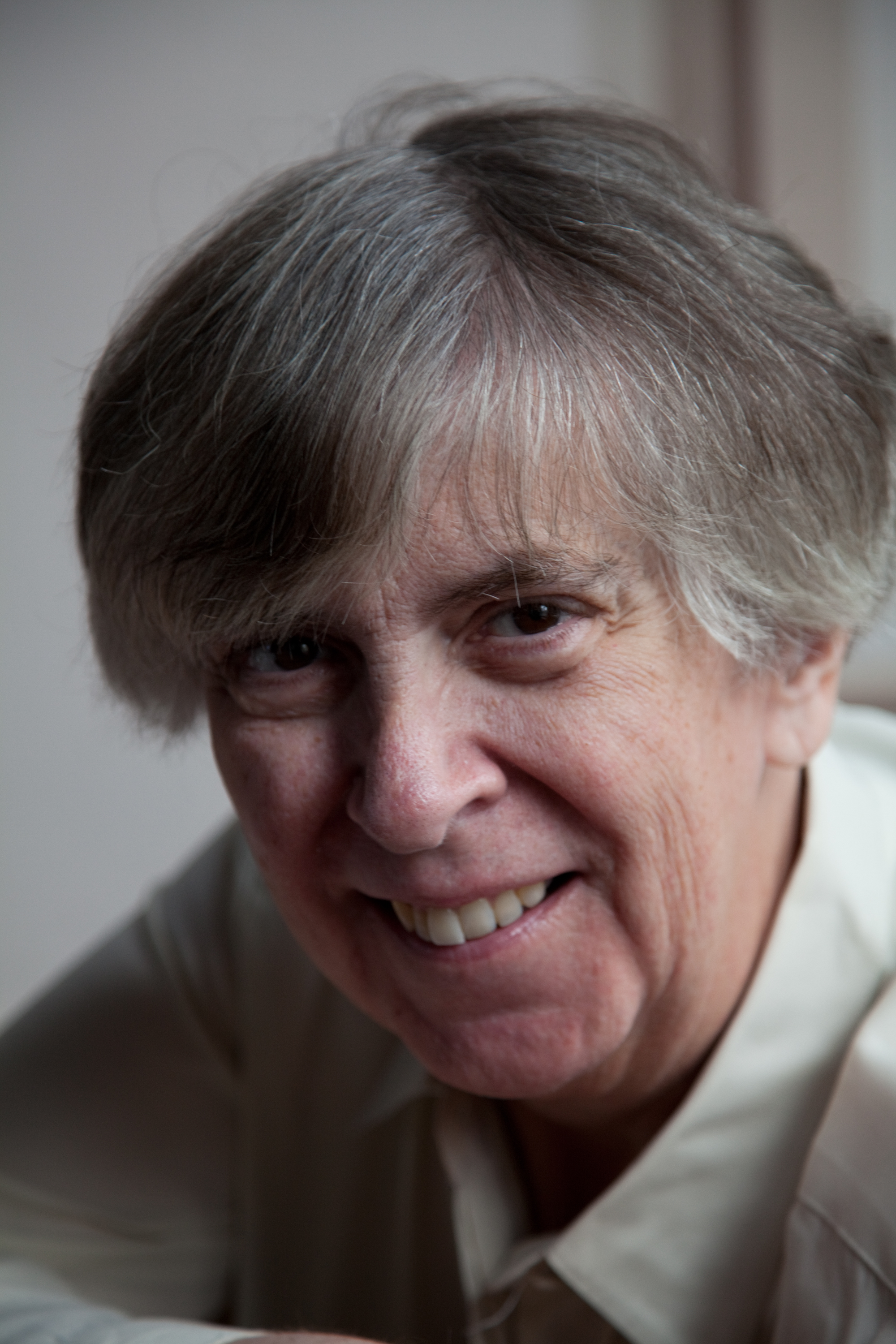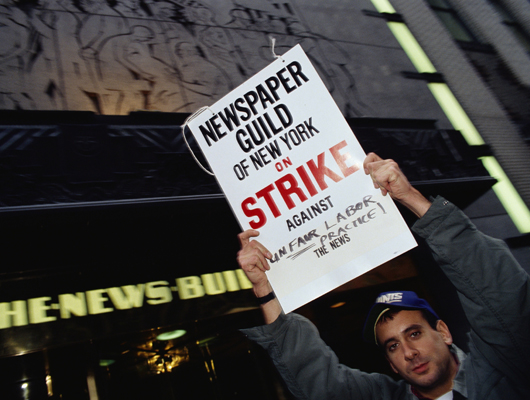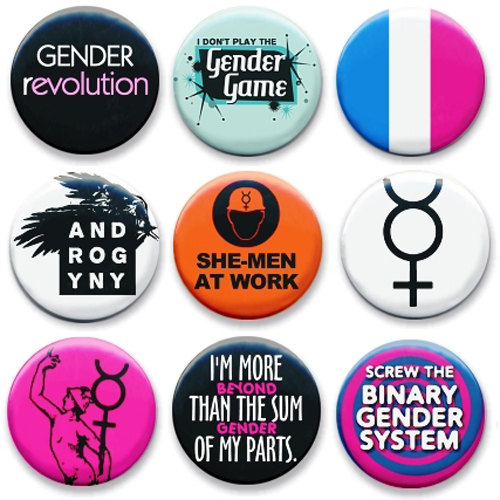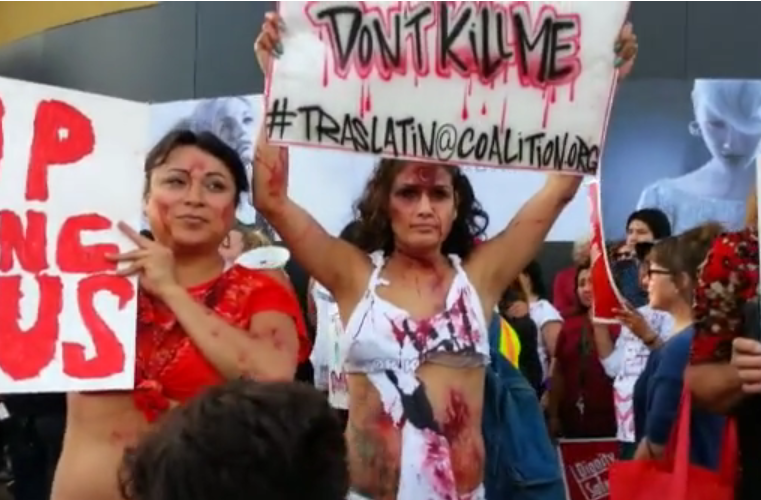Donna Cartwright
April 8, 2018
 Donna Cartwright. Photo: Mariette Pathy Allen
Donna Cartwright. Photo: Mariette Pathy AllenLooking back on nearly 25 years of involvement in the LGBT movement, and 45+ years in the labor movement, I am struck by the way those paths have crossed, intertwined and separated over the long term. This arc took me into unexpected territory, where queer identities, once deeply hidden and guarded, have achieved wide mainstream acceptance and support, while organized labor, once powerful and self-confident, now struggles to maintain its existence.
I went to work in my first union shop as a copy editor trainee at the Baltimore Sun in May 1969, barely a month before the Stonewall uprising that launched the queer activist movement into mainstream attention. At the time I didn’t identify as gay, but I understood that I had a gender issue; I thought even then that there was a relationship between gay/lesbian people and those who were gender nonconforming, although I would have been hard put to explain it. I know I felt a sense of satisfaction when I read about Stonewall.
However, my attention, as a convinced socialist, was largely focused on becoming a rank and file labor activist; a few months later, at the age of 22, I was a founding member of International Socialists (I.S.), a group best known for its focus on working in labor to build a radical rank-and-file movement from below.
In those days, the beginnings of labor’s long retreat were barely apparent – more a matter of slowed growth than serious defeats, or so it seemed at the time. In January 1970, when the Pressmen’s union went on strike against The Sun and Baltimore’s other local daily, the News American, all of the half dozen or so other unions (including my own, the Newspaper Guild) honored the Pressmen’s picket lines as a matter of course. We were out for almost 11 weeks, and neither paper tried to publish. The strike was settled in March, and all of the unions won hefty pay increases.
While I wanted to become a rank-and-file leader, I was handicapped by the deep uncertainty and guardedness that came from having what seemed an unspeakable secret. Shame, stigma and isolation prevented me from developing any real confidence and held me back as an activist.
I’m sure there were gay people at The Sun, and perhaps even other gender-nonconforming people, but if so they were as deep in the closet as I was. I had a few close calls, but I was never outed. I compartmentalized my queerness and was too afraid to try to connect with the growing queer movement. That was probably just as well – by the mid-70’s the organized gay and lesbian movement was increasingly unfriendly to gender-different people (“transgender” had not yet emerged as a widely accepted label). Gay men regarded trans women as an embarrassment, and lesbians often reviled transmasculine queer people as traitors who were seeking straight privilege.
With both my queer self and my labor activist self blocked, I let those dreams fade away. I was embarrassed that while my I.S. comrades were going into industry to build rank-and-file struggle, I really wasn’t doing very much at all. I resigned from I.S. in 1976, figuring I just wasn’t up to it.
Becoming a Rank and File Activist
But life has a way of changing unexpectedly. In early 1977, almost on a dare, I applied for a copy- editing job at The New York Times, and much to my surprise, I was hired. What I found there was a much more promising environment for an activist. Guild Local 3, in New York, was much more highly politicized than Local 35 in Washington-Baltimore, with distinct left and right wings. Labor’s crisis in the mid-1970’s was intensifying, and the newspaper industry was in the thick of it. In 1975-76, the Washington Post broke the Pressmen’s union, and reduced the remaining unions there to a weakened state that has persisted ever since.
 NY Daily News Strike Picketer. Photo:J A Giordano/CORBIS SABA
NY Daily News Strike Picketer. Photo:J A Giordano/CORBIS SABAElsewhere, publishers were emboldened and became more aggressive in demanding concessions from the unions. In New York, the Daily News forced a strike in June 1978 by the Newspaper Guild over the company’s demand for two-tier pay scales. Most of the unions honored the Guild’s picket lines, but crucially, the mobbed-up independent News and Mail Deliverers’ Union (NMDU), which organized the delivery truck drivers, scabbed. For two nights, there were wild, chaotic and violent confrontations on the picket lines, and a parked delivery truck was firebombed. The drivers stopped crossing the lines, but the strike was settled with major concessions by the Guild, including two-tier. This, in turn, sparked much anger in the ranks, and splits in the local leadership.
I quickly got involved with the left wing of the New York Guild, and was elected shop steward on the Times’ Foreign News Desk in 1979. For most of the next 15 years, left-leaning reformers fought to oust the local’s conservative, business unionist leadership, with only limited success. The Membership Slate (later to be reincarnated as the Rank and File Caucus), won shop-level and local elections in 1979 and 1980, but soon broke up and was forced from office. We fought on for more than a decade but were not able to mount another serious challenge for power in Local 3, the largest in the international union. I became a chief steward, shop vice chairperson and local Executive Board member, shedding some of my guilty feelings and rebuilding my self-esteem. Despite the defeats in bargaining and in union elections, I felt I had begun to vindicate my earlier dreams of playing a significant part in a revitalized working-class movement. But my trans side was still hungry, and was not fed.
First Steps
My first tentative steps to connect with that part of me took the form of reading. In the mid-80’s, I devoured Renee Richards’s autobiography, and saw enough similarities there that I decided I was probably transsexual. But I quickly decided to keep that secret locked up. I was too afraid of the consequences of coming out, and those fears were well founded.
 Camp Trans was established across from the Michigan Womyn’s Music Festival when transgender women were barred from attending. Photo: Mariette Pathy Allen
Camp Trans was established across from the Michigan Womyn’s Music Festival when transgender women were barred from attending. Photo: Mariette Pathy AllenIn the 1980’s, transgender people (a term that didn’t come into widespread use until around the end of the decade) were perhaps at their lowest point as a community and a movement. We were shunned by gay and lesbian organizations striving for respectability, excluded from Pride celebrations and parades, and denounced by many second wave feminists and gender normative gay men.
An Interesting Paradox
Nearing my 50th birthday, I began taking tentative steps into this strange new world. I found an interesting paradox – I had been active for most of my adult life in the organized labor movement, which had potentially great social power, but enormous inertia. Trans organizing, still in its infancy, had almost no social power, but far fewer restraints. In the late 90’s, we made it up as we went along.
Unions had dues-funded offices and staff that allowed them to survive in hard times, and to deliver gains to their members, although these were badly reduced. Their democratic structures allowed members at least the possibility of influencing the direction of the organization. But their history and relationships with employers and the state seriously crimped the possibility of genuine rank and file control.
While relatively small volunteer-run LGBT groups were usually ultra-democratic, with few officers and no money or staff, they lacked social weight. The larger LGBT organizations followed the board-and-staff NGO model, in which “members” donated money or took part in events but had no say in setting policy or priorities. Boards of directors were generally self-perpetuating, and priorities and direction were heavily influenced by the foundations that provided much of the money. This remains a key factor in skewing activism away from confronting employers and the super-rich.
Those differences mirrored another divergence – labor, although powerful, was (and is) under growing attack from employers, well-funded right-wing politicians, and even its supposed friends in the Democratic Party. Union membership and strike activity fell, and struggles were overwhelmingly defensive. Identity-based movements (women’s, LGBT etc.) also faced powerful enemies, but the overwhelming power of capital was not focused on destroying them. Instead, these movements increasingly focused on a narrowly defined liberal interest-group politics, striving to win inclusion within a competitive, hierarchical society. Demands became more focused on individual rights (reproductive autonomy, marriage equality, etc.) and less on economic equality and gains in the workplace. The needs of working-class women and queers were tacitly, but effectively, given lower priority.
Bridging Labor and Transgender Organizing
While I found all of this unfamiliar and sometimes disorienting, I managed to adjust, and spent much of the last 15 years or so fighting for transgender rights and inclusion.
 Transgender pride buttons
Transgender pride buttonsSometimes there was overlap – in the early 1990’s, a few years before I came out, gay and lesbian workers at The New York Times began to organize for domestic partner benefits and protection against discrimination. Union contract negotiations were beginning, and some of them came to me for advice (by that time I was well known as a union activist). I helped them write and circulate petitions for their demands to be included in the bargaining; somewhat to my surprise, this was accomplished without much difficulty. About 10 years later, I pressed for inclusion of transgender people in the nondiscrimination clause of the union contract, again successfully.
I was also able to combine union and LGBT activism on a more sustained basis outside the workplace. I became the first transgender board member of Pride at Work, the LGBT constituency group of the AFL-CIO, in 2002, and worked with queer brothers and sisters to make sure that the labor movement threw its weight behind those insisting on local, state and federal anti-discrimination legislation that is fully inclusive of trans people. From 2009 through 2012, I was Pride at Work’s first transgender co-President.
Looking back across this long arc, I see that social justice movements from below have opened undreamt-of hopes and possibilities, but at the price of a shady and corrupt bargain. The billionaire class offers a future in which all kinds of marginalized groups can believe that everyone, regardless of race, sex, sexuality, ethnicity, gender identity, etc., should have an equal opportunity to serve the moneyed elite. In return, the ruling class requires that we accept subordination, seek the favor of our “betters” to compete for scarce perks, and avoid raising demands for systemic change.
 Demonstrators shut down L.A. intersection to protest murders of transwomen (March 2015) Photo: Katie Falkenberg/Los Angeles Times)
Demonstrators shut down L.A. intersection to protest murders of transwomen (March 2015) Photo: Katie Falkenberg/Los Angeles Times)The “bargain” we are offered is a fraud. Trans people, along with other oppressed sectors, are far from achieving this promise of identity-based equality. With those others, we remain subject to economic discrimination and state and private violence. While some marginalized groups may see one or another of their own in a position of power, the elite reproduces itself and its general system of political and economic domination, while changing its internal composition only slowly, if at all. What do we need? The social power of the working class, the energy and innovation of long marginalized groups, in movements that demand wholesale systemic change, not piecemeal adjustments.
Donna Cartwright is a member of Solidarity in Baltimore; she is active in labor, single payer and LGBT rights campaigns.
